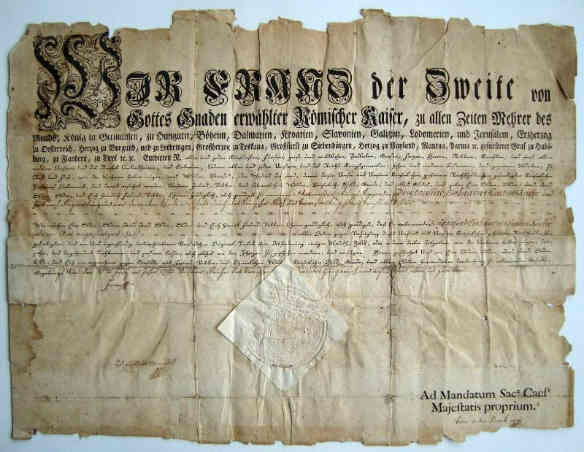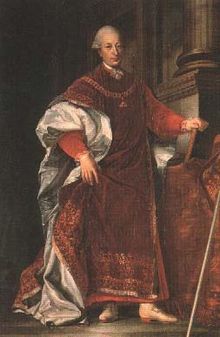Passbrief (Passport) 1793 Holy Roman Empire
This Passbrief (Passport) 1793 of the Holy Roman Empire
The Holy Roman Empire
was a mulch-ethnic complex of territories in central Europe that developed during the Middle Ages and continued until its dissolution in 1806. The core and largest territory of the empire was the Kingdom of Germany, though it included at times the Kingdom of Italy, the Kingdom of Bohemia, and the Kingdom of Burgundy, as well as numerous other territories.
The empire grew out of East Francia, a primary division of the Frankish Empire. On Christmas Day 800, Pope Leo III crowned the Frankish king Charlemagne as Emperor, reviving the title in Western Europe after more than three centuries. After Charlemagne died, the title passed in a desultory manner during the decline and fragmentation of the Carolingian dynasty, eventually falling into disuse by 924. The title was revived in 962 when Otto I was crowned emperor, fashioning himself as the successor of Charlemagne and beginning a continuous existence of the empire for over eight centuries. Some historians refer to the coronation of Charlemagne as the origin of the empire, while others prefer the coronation of Otto I as its beginning. Scholars generally concur, however, in relating an evolution of the institutions and principles comprising the empire, describing a gradual assumption of the imperial title and role.
The precise term Holy Roman Empire was not used until the 13th century, but the concept of translatio imperii (“transfer of rule”) was fundamental to the prestige of the emperor, the notion that he held supreme power inherited from the emperors of Rome.[9] The office of Holy Roman Emperor was traditionally elective, although frequently controlled by dynasties. The German prince-electors, the highest ranking noblemen of the empire, usually elected one of their peers as “King of the Romans”, and he would later be crowned emperor by the Pope; the tradition of papal coronations was discontinued in the 16th century. The empire never achieved the extent of political unification formed in France, evolving instead into a decentralized, limited elective monarchy composed of hundreds of sub-units, principalities, duchies, counties, Free Imperial Cities, and other domains. The power of the emperor was limited, and while the various princes, lords, and kings of the empire were vassals and subjects who owed the emperor their allegiance, they also possessed an extent of privileges that gave them de facto sovereignty within their territories. Emperor Francis II dissolved the empire in August 1806 after its defeat by Napoleon at the Battle of Austerlitz.
 Franz de Paula Gundaker von Colloredo-Mannsfeld
Franz de Paula Gundaker von Colloredo-Mannsfeld
(born May 28, 1731 in Vienna, † October 27, 1807 ibid) was the last imperial vice-chancellor of the Holy Roman Empire. His father was the Vice Chancellor Rudolph Joseph von Colloredo-Waldsee. One of his brothers was the Archbishop of Salzburg, Hieronymus Colloredo. He married in 1771 Maria Isabella, the daughter of Prince Heinrich Franz Mannsfeld and Fondi and granddaughter of Heinrich Franz von Mannsfeld. As this had no male offspring, it came after his death to name and coat of arms union. His second wife married Prince Colloredo–Mannsfeld 1797 Maria Josepha of Schrattenbach, the widow of Count Guidobald Ditrichstein and of Count Johann Joseph von Khevenhüller-Metsch. From his first marriage came three sons and two daughters. Among his sons were among the Field-Marshal Lieutenant Hieronymus von Colloredo-Mannsfeld and the diplomat and politician Ferdinand Colloredo–Mannsfeld.

FAQ Passport History
Passport collection, passport renewal, old passports for sale, vintage passport, emergency passport renewal, same day passport, passport application, pasaporte passeport паспорт 护照 パスポート جواز سفر पासपोर्ट
1. What are the earliest known examples of passports, and how have they evolved?
The word "passport" came up only in the mid 15th Century. Before that, such documents were safe conducts, recommendations or protection letters. On a practical aspect, the earliest passport I have seen was from the mid 16th Century. Read more...
2. Are there any notable historical figures or personalities whose passports are highly sought after by collectors?
Every collector is doing well to define his collection focus, and yes, there are collectors looking for Celebrity passports and travel documents of historical figures like Winston Churchill, Brothers Grimm, Johann Wolfgang von Goethe. Read more...
3. How did passport designs and security features change throughout different periods in history, and what impact did these changes have on forgery prevention?
"Passports" before the 18th Century had a pure functional character. Security features were, in the best case, a watermark and a wax seal. Forgery, back then, was not an issue like it is nowadays. Only from the 1980s on, security features became a thing. A state-of-the-art passport nowadays has dozens of security features - visible and invisible. Some are known only by the security document printer itself. Read more...
4. What are some of the rarest and most valuable historical passports that have ever been sold or auctioned?
Lou Gehrig, Victor Tsoi, Marilyn Monroe, James Joyce, and Albert Einstein when it comes to the most expensive ones. Read more...
5. How do diplomatic passports differ from regular passports, and what makes them significant to collectors?
Such documents were often held by officials in high ranks, like ambassadors, consuls or special envoys. Furthermore, these travel documents are often frequently traveled. Hence, they hold a tapestry of stamps or visas. Partly from unusual places.
6. Can you provide insights into the stories behind specific historical passports that offer unique insights into past travel and migration trends?
A passport tells the story of its bearer and these stories can be everything - surprising, sad, vivid. Isabella Bird and her travels (1831-1904) or Mary Kingsley, a fearless Lady explorer.
7. What role did passports play during significant historical events, such as wartime travel restrictions or international treaties?
During war, a passport could have been a matter of life or death. Especially, when we are looking into WWII and the Holocaust. And yes, during that time, passports and similar documents were often forged to escape and save lives. Example...
8. How has the emergence of digital passports and biometric identification impacted the world of passport collecting?
Current modern passports having now often a sparkling, flashy design. This has mainly two reasons. 1. Improved security and 2. Displaying a countries' heritage, icons, and important figures or achievements. I can fully understand that those modern documents are wanted, especially by younger collectors.
9. Are there any specialized collections of passports, such as those from a specific country, era, or distinguished individuals?
Yes, the University of Western Sidney Library has e.g. a passport collection of the former prime minister Hon Edward Gough Whitlam and his wife Margaret. They are all diplomatic passports and I had the pleasure to apprise them. I hold e.g. a collection of almost all types of the German Empire passports (only 2 types are still missing). Also, my East German passport collection is quite extensive with pretty rare passport types.
10. Where can passport collectors find reliable resources and reputable sellers to expand their collection and learn more about passport history?
A good start is eBay, Delcampe, flea markets, garage or estate sales. The more significant travel documents you probably find at the classic auction houses. Sometimes I also offer documents from my archive/collection. See offers... As you are already here, you surely found a great source on the topic 😉
Other great sources are: Scottish Passports, The Nansen passport, The secret lives of diplomatic couriers
11. Is vintage passport collecting legal? What are the regulations and considerations collectors should know when acquiring historical passports?
First, it's important to stress that each country has its own laws when it comes to passports. Collecting old vintage passports for historical or educational reasons is safe and legal, or at least tolerated. More details on the legal aspects are here...
Does this article spark your curiosity about passport collecting and the history of passports? With this valuable information, you have a good basis to start your own passport collection.
Question? Contact me...


